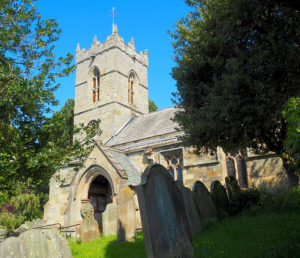Thornton le Dale is an attractive small village on the edge of the North York Moors and is very geared up for day trippers and coach trips. It has a very good “website”:https://www.visitthorntonledale.co.uk/ with a map showing the layout of the village, where the shops are, local attractions and ideas of short walks.
It really can be described as a ‘honey pot ‘ village and is always busy with its beck, ducks, stone cottages and even a thatched cottage.
The main village is a linear village along the main Pickering to Scarborough road and is made up of terraces of attractive C18th stone built cottages. At the centre of the village is a small green area with a large chestnut tree and the market cross, although it no longer has its market. The village stocks were here. There are plenty of seats around here and it is a pleasant place to drop out and people watch.
The shops are found on the roads radiating from here. Shops are small and family owned. The chains haven’t reached here, but most are geared to day visitors with a lot of eateries, cafes, gift shops and ice cream parlours. There is even a chocolate factory shop next to the Lavender tearoom.
“All Saints’ Church”:https://www.silvertraveladvisor.com/travel-product/attraction/141080-all-saints-church on hill overlooking the village, has Norman origins and still has a Norman font, although present building is C14th.
The small row of Almshouses at the end of the village were built in 1656 by local landowner, Lady Lumley, who died aged 80 with no children. She left her estate to a charity trust to build 12 almshouses and a grammar school, for children from Thornton and nearby Sinnington, which apparently was open to all local children who could read the New Testament. 200 children could be educated in the large schoolroom. The school is at the end of the row of almshouses but is not used, as a new school was built in Pickering.
Perhaps what makes Thornton le dale so popular is the beck that runs through the village. Thornton Beck was used to power the many water mills and the remains of weirs can still be seen.
Near the car park is a small lake, referred to as The Pond. I assume this is man made and connected to the water mills along the Beck, but I’ve not been able to find any information about it. There is a very easy walk around the pond with information boards. There are also ducks and geese.
Beck Isle Footpath begins where the main road crosses the Beck and is a paved path running alongside the Beck. It passes the C17th thatched cottage, which is probably one of the most photographed cottages in North Yorkshire and regularly appeared on biscuit tins.
This is a very popular walk with seats overlooking the Beck. In warm weather this is a popular paddling spot for local children and visitors.
I’m still not sure why so many people visit Thornton le Dale. It is an attractive village, but then there are many other attractive villages in the area. It has the advantage of having a large car park in what was the walled garden of the manor house (now a retirement home) as well as public toilets. This may explain why so many coach tours stop here. I’m not quite sure what people do once here. Many of them seem to wander aimlessly round the village eating an ice cream and debating the merits of the different cafes. For those prepared to walk, there is a delightful short walk up Thornton Beck to the isolated settlement of Ellerburn.














